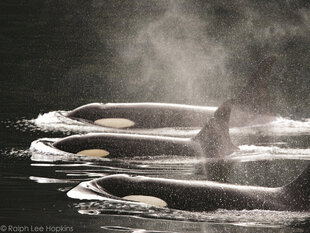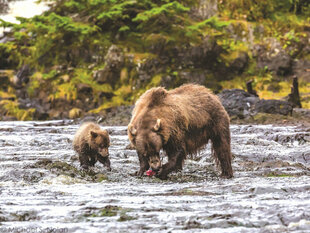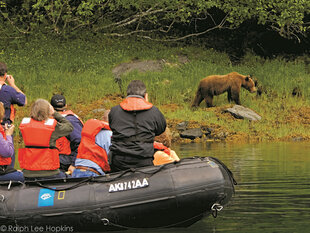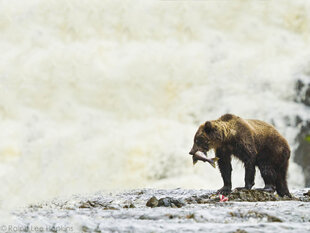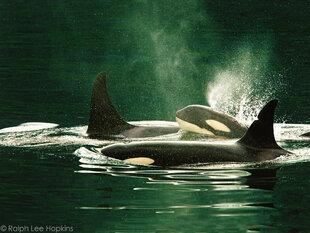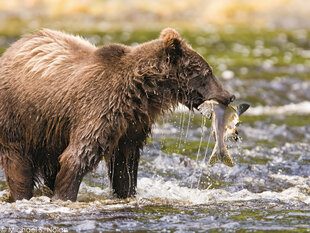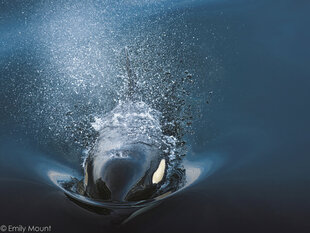Alaska is home to a very large population of Brown and Black bears potentially 85,000 strong. Black bears are the smallest bear species in North America, reaching up to 1 m (3.3 ft) at shoulder height and 2 m (6.6 ft) from head to tail and males weigh up to 250 kg (550 lbs). Most of what they eat consists of insects like bees, ants and beetles but they also famously love honey. The huge and infamous Brown or Grizzly bear is closer to 390 kg (860 lbs) and roams the banks of fjords and rivers through the summer months looking for food. They eat a wide range of food, from berries and nuts to moose and bison; but, most iconically, Black and Brown bears love to eat salmon during an annual event known as the salmon run.
To breed, salmon species swim back up the rivers from which they were born, meaning that huge numbers of these fish can be found heading up the fjords in this area. This makes finding bears during this time of the year relatively simple and they will often wait at rapids for salmon to literally jump into their mouths. This we can watch on rigid inflatable boats (RIBs or Zodiacs) at Verney Falls.
Of course, there is far more wildlife here than just bears: the fjords are home to Killer Whales, Harbour Seals and many species of seabird at this time of year. Birds of Prey, like the Golden Eagle, and River Otters will also be taking advantage of the influx of salmon, so there should be plenty of opportunities to see some incredible wildlife encounters on this trip.
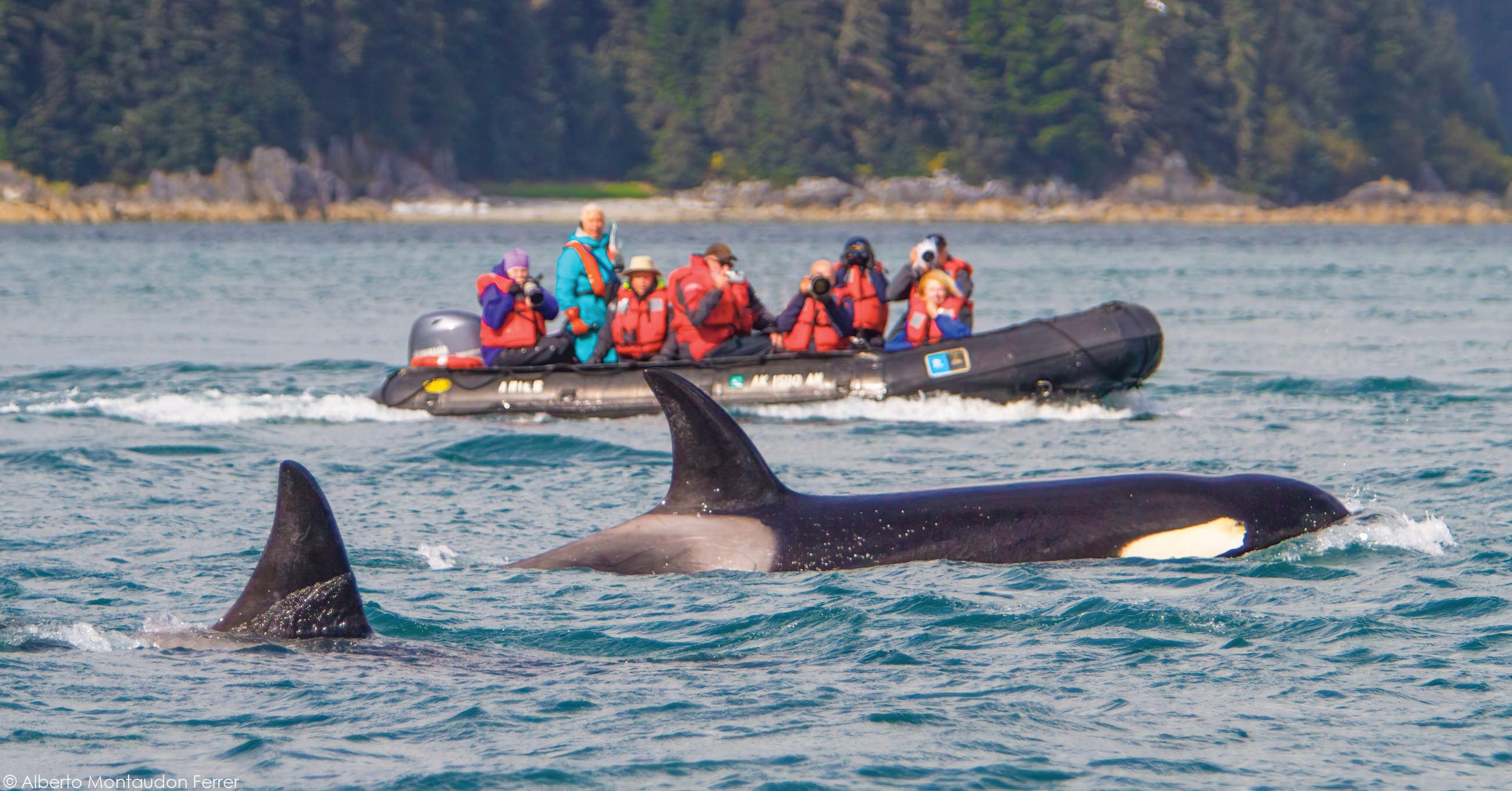
There are also fascinating excursion opportunities here, with a journey into forests inaccessible by road, kayaking with huge conglomerations of jellyfish and hiking on the San Juan Islands all a possibility. These activities and the panoramic views the ship can offer mean that you can experience the grandeur of the surroundings for the itinerary’s entire duration and from all the best angles.
Itinerary
Please note that this itinerary is written to provide a flavour of each voyage. The actual route will vary according to choice of vessel, the captain and expedition team in accordance with prevailing ice, weather and sea conditions and opportunities to see wildlife and wilderness scenery.
Day 1 – Ketchikan
Arrive in Ketchikan, the southernmost city in Alaska, spread at the base of forested slopes of Revillagigedo Island. Known as the ‘salmon capital of the world’, it's famous for colourful buildings and abundant fishing boats and canneries. Embark National Geographic Venture in time for cocktails and an introduction of the vessel staff and crew.
Day 2 – Prince Rupert
Wake up in Prince Rupert, a scenic harbour town on British Columbia’s rugged northwest coast. Become immersed in First Nations history at the Museum of Northern British Columbia, built in the style of a coastal longhouse. Breathe in the scent of cedar beams and peruse an impressive collection of ornate carvings, weavings, ceremonial objects and regalia. Visit the North Pacific Cannery Museum, a collection of cannery buildings located in pristine wilderness surroundings that highlight British Columbia’s economic, cultural and natural development over the last century.
Day 3 – Lowe Inlet
Seek out pods of killer whales and foraging bears as you sail north through the narrow Grenville Channel between Pitt Island and the mainland, a dramatic navigational experience. Not only does the channel narrow to less than a quarter of a mile across, but a slight bend in the passage makes the waterway seem to disappear into the hills ahead and behind the ship. Here, you'll explore the salmon run at Verney Falls in Lowe Inlet Provincial Marine Park by Zodiacs.
Days 4-7 – Great Bear Rainforest & Coastline Navigation
Over the course of the next four days, you will cruise far into the fjords and deep valleys that carve into the Coast Range looking for black and grizzly bears. You will cruise the eastern coast of Princess Royal Island in search of the elusive spirit bear. It is believed that between 10 to 20 percent of bears in this region are born with the recessive gene that causes the white fur; fewer than 400 are estimated to exist.
British Columbia has one of the highest proportions of protected land of any jurisdiction in the world. Almost 15 percent of the land is protected, with a wide range of provincial parks, national parks and UNESCO World Heritage Sites. Alongside your veteran expedition team, go ashore and explore several remote locations where few people venture. Discover hidden gems by Zodiac and kayak, navigating the tidal narrows that lead to the backs of bays while scanning for bears along the rocky shoreline and meadows such as Gilttoyees Inlet.
Days 8 & 9 – Johnstone Strait & Southern British Columbia
The ship will aim to navigate the scenic Johnstone Strait: a dramatic waterway cutting through mountains and islands rich with marine wildlife. Here you will be able to explore the myriad islets and rocky coasts, keeping an eye out for harbour seals, diverse seabirds, and birds of prey.
British Columbia’s Sunshine Coast is a mecca for kayakers and small yachts. The ship will aim to anchor in calm, sheltered waters so that those who wish can kayak in isolated bays that beckon for exploration. On land, hike through meadows and forest ecosystems.
Day 10 – San Juan Islands
The ship aims to be amongst the wild charm of the San Juan Islands - a captivating archipelago in northern Washington State. There may be opportunities here to paddle hidden coves by kayak, keeping an eye out for friendly harbour seals. There will also be opportunities to navigate dramatic shorelines aboard Zodiacs. Hike along rugged coastal trails where bald eagles soar overhead, while expert naturalists provide insight on the fascinating ecology and cultural history of this distinctive northwest wilderness.
Day 11 – Seattle & Departure
Breakfast and disembark in Seattle and transfer to the airport for flights home.
Dates
For departures in 2026 and 2027 or for a longer itinerary with the Great Bear Rainforest, visit our Exploring Alaska, Great Bear Rainforest and the San Juan Islands experience.
Included
- Excursions, hotels, and airport transfers, as indicated in the itinerary?
- Selection of exploration tools curated to your destination, such as Zodiacs and stand-up paddleboards, kayaks and other state-of-the-art gear
- Guidance and company of our leading expedition staff?
- All meals as indicated in the itinerary, both aboard and onshore. Meals are inspired by regional cuisine and locally sourced where possible.
- Hors d’oeuvres inspired by regional cuisine and locally sourced where possible
- 24-hour access to snacks, premium coffees and teas, non-alcoholic beverages, and filtered water
- Beer, wine, cocktails, liquors and spirits. We are also pleased to offer a selection of premium brands available for purchase.
- Complimentary Starlink-enabled Wi-Fi internet is available to all guests, enabling email, messaging, and social media.
- Presentations on your destination by expedition staff and expert guest speakers
- Complimentary reusable water bottle to fill at onboard water refill stations
- Morning stretch classes and 24-hour access to exercise equipment where available?
- 24-hour access to lounges, observation decks, library stocked with regionally relevant literature, and other shared spaces?
- Access to the OM System Photo Gear Locker with the latest gear to try out on loan
- Park and site entrance fees, special access permits, and port taxes
Not Included
- Travel insurance
- Enhanced and Premium internet packages are available for purchase, which may enable video chat, web browsing, and streaming (connectivity permitting).

